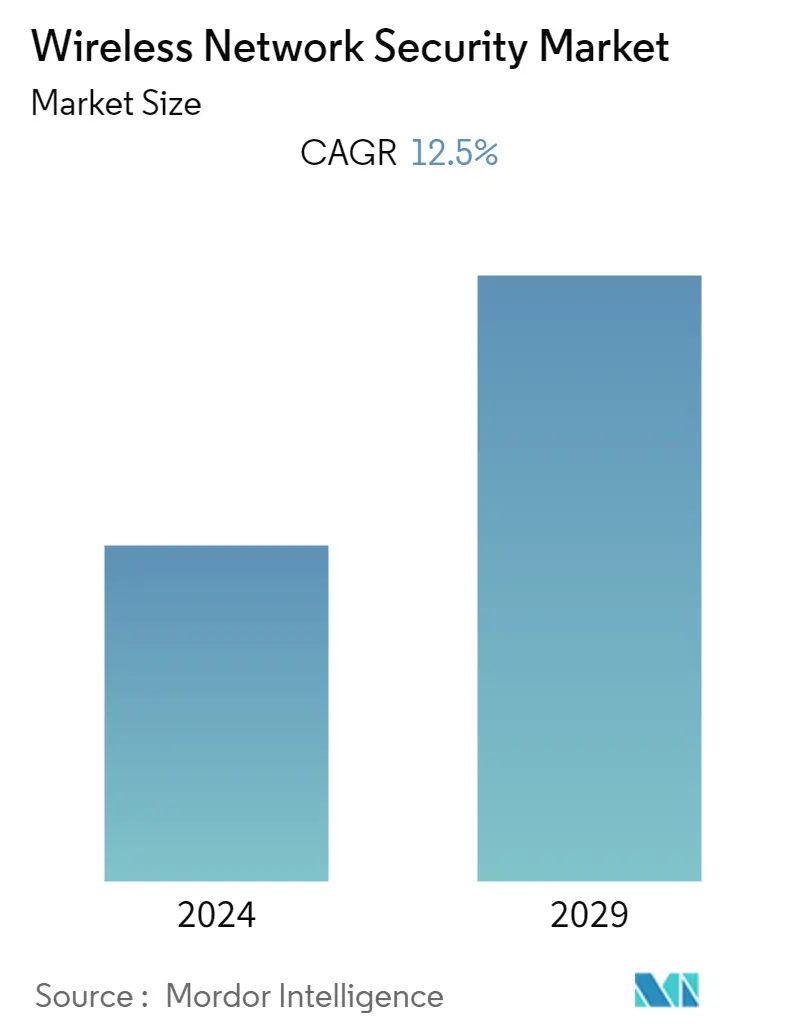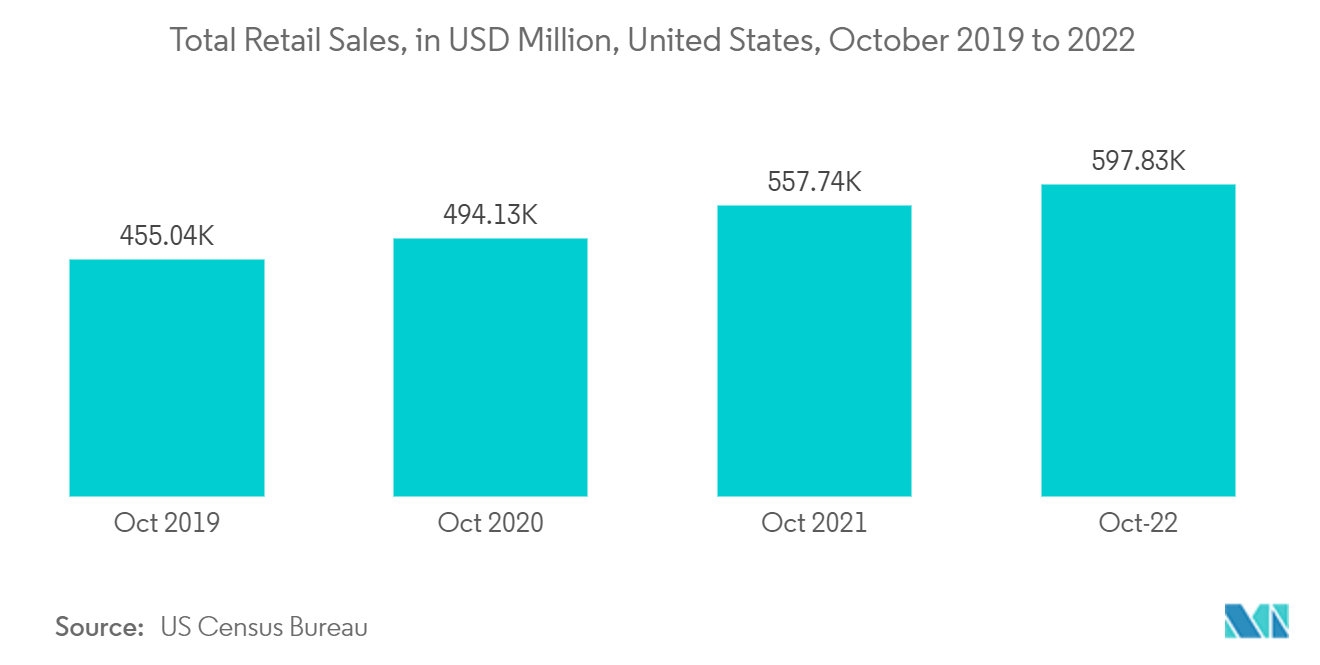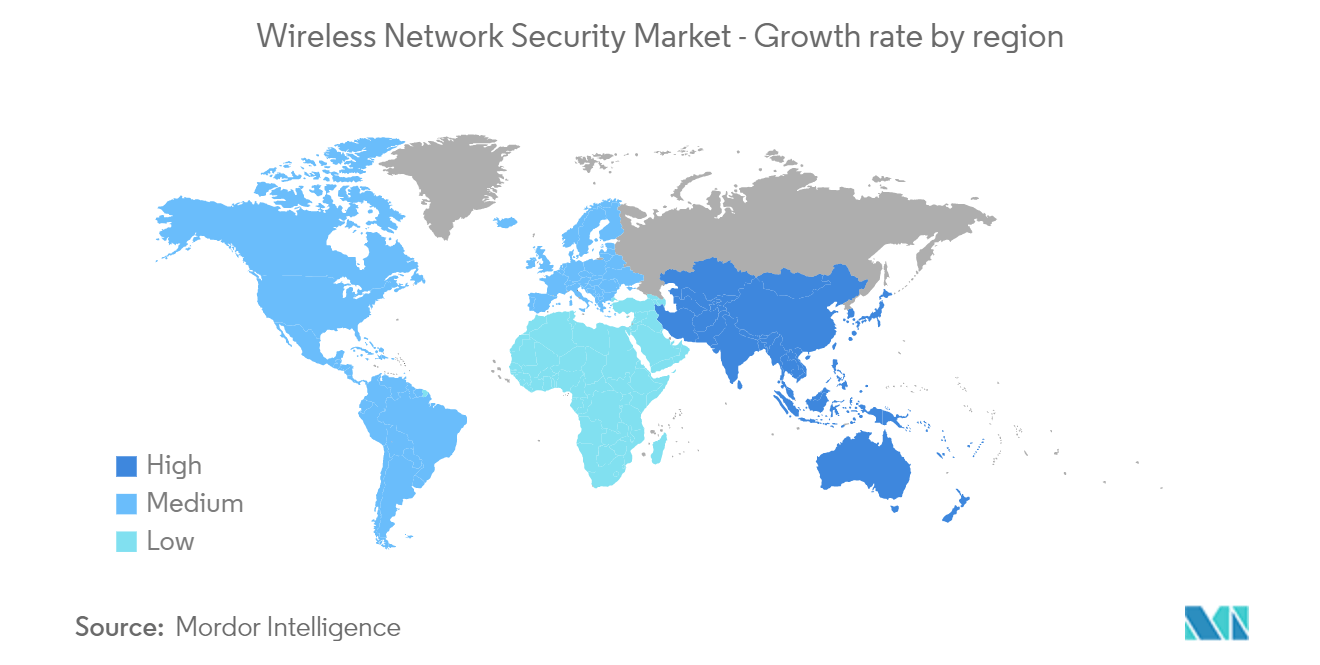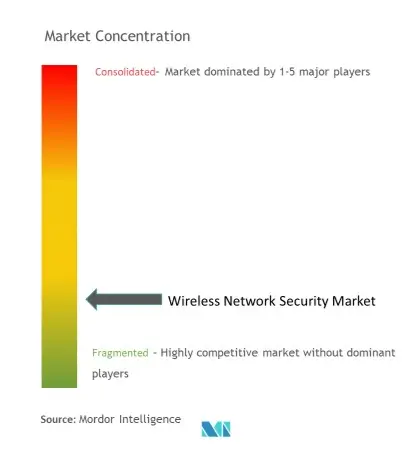Wireless Network Security Market Size

| Study Period | 2019 - 2029 |
| Base Year For Estimation | 2023 |
| CAGR | 12.50 % |
| Fastest Growing Market | Asia Pacific |
| Largest Market | North America |
| Market Concentration | Low |
Major Players
*Disclaimer: Major Players sorted in no particular order |
Wireless Network Security Market Analysis
The wireless network security market is expected to register a CAGR of over 12.5% over the forecast period. The increasing consumer propensity toward adopting wireless devices in residential and commercial spaces is augmenting the wireless network security demand.
- The growing number of enterprises opting for digital networks and mobile devices is further influencing the market. According to a report from the Wireless Broadband Alliance (WBA), more than a third (33%) of service providers, technology vendors, and enterprises already have plans to deploy Wi-Fi 7 by the end of last year. Moreover, the report also revealed that Wi-Fi 6E had become the de facto industry standard, with 53% having already deployed the technology and a further 44% working on plans to adopt Wi-Fi 6E in the next 12-18 months. Such developments are expected to influence enterprises to enhance their security as well.
- The global adoption of Wi-Fi is on the rise in both commercial and residential space, with a growing number of mobile devices that are connected to high-speed internet is on the rise. According to Cisco, the Wi-Fi hotspots are expected to grow to 628 million public Wi-Fi hotspots by this year from 169 million in 2018. The growing adoption of IoT augments growth. With the change in the number of Wi-Fi hotspots, security risks are increasing, and these enterprises are moving toward adopting robust encryption. WEP uses an old encryption method and holds prominence in old systems, whereas WPA is one of the widely used standards among network devices.
- WEP and TKIP protocols were deemed insecure many years ago. Wi-Fi connections carried out via these protocols can be decrypted relatively quickly, and various hardware vendors are increasingly avoiding these protocol usage. Starting with May 2019, Windows 10 warned its users if they attempted to connect to a Wi-Fi network that uses these protocols. Apart from this, WPA-enabled devices are prone to attacks. For instance, a new bug present on the chips made by Broadcom and Cypress rendered about one billion devices vulnerable to an attack that can decrypt information in transit, and the bug is called 'Kr00k'. Using the flaw, attackers can exfiltrate information by intercepting and decrypting packets sent over the WPA2 network.
- Devices, such as Amazon Echo, Kindle, iPhone, iPad, MacBook, Google Nexus, Samsung Galaxy, Raspberry Pi 3, Xiaomi, and some Asus and Huawei products, tested positive for Kr00k vulnerability. Due to such developments, the wireless security demand is expected to become vital, especially in network-handling mission-critical workloads. With the increasing deployment of IoT and BYOD trends, the need for wireless network security is expected to be one of the enterprises' priorities. According to a study by Outpost24, 61% of security experts mentioned that BYOD offers a severe threat to their organization, and 21% feared attacks via office-based IoT devices, such as printers. The greatest wireless attack threats were password theft at 62% and Botnet/Malware threats at 60%.
- Further, emerging economies plan to boost connectivity to contribute to the market growth rate. For instance, Brazil announced plans to increase public Wi-Fi availability. According to the technical cooperation agreements signed by the Banco do Brasil Foundation and the Brazilian Micro and Small Business Support Service (SEBRAE) with the Ministry of Communications, approximately 500 new Wi-Fi hotspots will be put in place by last year, benefiting 1,000 locations nationwide. The growing adoption of IoT augments growth. With the change in the number of Wi-Fi hotspots, security risks are increasing, and these enterprises are moving toward adopting robust encryption.
- The CISA (Cybersecurity and Infrastructure Security Agency), which is a part of the Department of Homeland Security, warned of COVID-19 network-security issues, with the most common including phishing, malware distribution, registration of new domain names containing wording related to coronavirus or COVID-19 and attacks against newly and often rapidly deployed remote-access and teleworking infrastructure. In April 2020, CISA released new guidance on how remote government workers and potentially others should address network security. It included interim Trusted Internet Connections (TIC) 3.0 advice to aid agencies in securing their network and cloud environments.
Wireless Network Security Market Trends
This section covers the major market trends shaping the Wireless Network Security Market according to our research experts:
Retail is Expected to Hold a Significant Share
- The retail industry is witnessing growth in the last two years, especially with the massive expansion of the e-commerce industry across the globe. Hence, retailers are utilizing IoT solutions to improve their operational efficiency and enhance the customer experience to gain competitive advantages. With the increasing IoT use in retail space, the wireless security demand is expected to augment over the forecasted period. Retail companies are facing a landscape filled with growing and increasingly sophisticated threats, and the financial impact of these breaches is soaring.
- Moreover, the number of IoT-connected devices in retail is increasing exponentially. For instance, in the EU alone, the number of connected devices used in the retail industry was 2.28 million units in 2019 and is expected to grow to 3.09 million units by 2025, as per ENTO reports. IoT plays a significant role in process automation and enhancing retail stores' operational efficiency. It provides energy optimization, surveillance and security, supply chain optimization, inventory optimization, and workforce management. Also, IoT is gaining capabilities in cold chain monitoring for temperature-sensitive grocery and pharmaceutical goods.
- For instance, Aruba is reshaping its edge networking with a more user-friendly configuration for its SDBranch, enabling more secure, simplified deployment and managing large distributed retail networks. IoT is also helping retailers to offer better customer experience, hence helping gain profit margins. For instance, US-based retailer Walgreens is experimenting with IoT-enabled displays on refrigerator doors that utilize face detection technology to show ads based on approximate age and gender. Many European retailers are installing small, customizable, IoT-connected dashboards or buttons to gather customer feedback and use those insights to enhance customer experiences.

North America is Expected to Hold a Major Share
- North America is expected to contribute to the market's growth significantly. The United States plays a crucial role in generating demand from the region compared to Canada. The area is a pioneer in advanced technology adoption. Additionally, the presence of large enterprises, the increasing network attack frequency, and the growing number of hosted servers in the United States are driving the market growth. Moreover, the region includes a significant foothold of critical vendors in the market. Some include Cisco Systems, Juniper Networks, Inc., Fortinet, Inc., and Symantec Corporation.
- Moreover, cyberattacks in the North American region, especially in the United States, are rising rapidly. They have reached an all-time high, primarily owing to the rapidly increasing number of connected devices in the region. In the United States, consumers use public clouds, and many mobile applications are preloaded with personal information for the convenience of banking, shopping, communication, etc. With the increasing smart home environment in the United States, the possibility of security and privacy hazards through exploiting malicious hackers is also rising.
- The United States includes the highest wireless devices adoption. The growth in wireless devices is fueling robust security solutions to protect the misuse and unauthorized access of data. For instance, according to Cisco Systems Inc., among the countries with the highest average per capita devices and connections by 2023 United States would be leading with 13.6%. Cloud and digital transformation increased the overall data breach cost. Increasing cloud migration, mobile platforms usage, and IoT devices were drivers in the region. Organizations in the United States had the highest price at USD 8.19 million, which is the average cost of a lost or stolen record.
- In September 2022, the National Institute of Standards and Technology (NIST) issued draft security recommendations for IoT devices in the United States. Because IoT regularly poses a cybersecurity risk through hacks and data breaches, the NIST's Core Baseline highlights a list of recommended security features for manufacturers to incorporate into their IoT devices and guidelines for consumers to look for on a device's box or online description while shopping.
- Moreover, in November 2022, the US Federal Communications Commission (FCC) announced the ban on telecommunications and video surveillance equipment from prominent Chinese brands, including Huawei and ZTE. US security officials have alerted that equipment from Chinese brands such as Huawei could be used to interfere with fifth-generation (5G) wireless networks and collect sensitive information. Such rising threats are expected to increase the demand for wireless network security solutions over the forecast period.

Wireless Network Security Industry Overview
The wireless network security market is fragmented; many players, such as Cisco Systems, Inc., Juniper Networks, Symantec Corporation, Fortinet, Inc., and Aruba Networks, occupy a smaller market share. The players are pursuing a mergers and acquisitions strategy to strengthen their product portfolio. Also, companies in the market are continually updating their existing product portfolio with the latest technologies.
- December 2022 - Cradlepoint launched its zero-trust network access (ZTNA) service as part of the NetCloud Exchange (NCX) platform, including its Secure Connect and Advanced SD-WAN products. NetCloud software platform that supports wireless WAN delivered through 4G LTE and 5G wireless edge routers.
- September 2022 - Broadcom launched the Trident chip targeting advanced enterprise network security by taking advantage of a basic security principle. The new Trident chip, which boasts 12.8 terabits per second (Tbps) of switching capacity, provides enterprises with enhanced security built specifically for the core corporate network layer. The chip offers fingerprinting capability and probes necessary for artificial intelligence (AI) and machine learning-based servers to perform threat detection and response.
Wireless Network Security Market Leaders
-
Cisco Systems Inc.
-
Juniper Networks Inc.
-
Fortinet Inc.
-
Aruba Networks (HPE)
-
Broadcom Inc. (Symantec Corporation)
*Disclaimer: Major Players sorted in no particular order

Wireless Network Security Market News
- November 2022 - Fortinet announced the launch of the FortiGate Cloud-Native Firewall (CNF) on Amazon Web Services (AWS). The new cybersecurity solution, available as a software as a service (SaaS), is aimed at enterprises using AWS looking for enterprise-grade next-generation firewall (NGFW) functionality with cloud-native support.
- July 2022 - Spectrum announced the Security Shield launch, an artificial intelligence (AI) enabled cybersecurity solution for Advanced WiFi customers across its 41-state service area. This automatically-enabled security capability defends customers and their devices from internet threats while also providing enhanced network visibility for the customer.
Wireless Network Security Market Report - Table of Contents
1. INTRODUCTION
- 1.1 Study Assumptions and Market Definition
- 1.2 Scope of the Study
2. RESEARCH METHODOLOGY
3. EXECUTIVE SUMMARY
4. MARKET INSIGHTS
- 4.1 Market Overview ( Covers the impact of COVID-19)
-
4.2 Industry Attractiveness - Porter's Five Forces Analysis
- 4.2.1 Bargaining Power of Suppliers
- 4.2.2 Bargaining Power of Buyers/Consumers
- 4.2.3 Threat of New Entrants
- 4.2.4 Threat of Substitute Products
- 4.2.5 Intensity of Competitive Rivalry
5. MARKET DYNAMICS
-
5.1 Market Drivers
- 5.1.1 Growth of the Wireless Network Traffic
- 5.1.2 Extensive Cloud Migration, Use of Mobile Platforms, and IoT devices
-
5.2 Market Restraints
- 5.2.1 Rising Piracy of the Wireless Network Security Solutions
6. TECHNOLOGY SNAPSHOT
7. MARKET SEGMENTATION
-
7.1 By Solution
- 7.1.1 Firewall
- 7.1.2 Encryption
- 7.1.3 Identity and Access Management
- 7.1.4 Unified Threat Management
- 7.1.5 Intrusion Prevention System (IPS)/Intrusion Detection System (IDS)
- 7.1.6 Other Solutions
-
7.2 By Deployment
- 7.2.1 On-premise
- 7.2.2 Cloud
-
7.3 By End-user Industry
- 7.3.1 BFSI
- 7.3.2 Healthcare
- 7.3.3 Retail
- 7.3.4 Manufacturing
- 7.3.5 IT and Telecom
- 7.3.6 Government
- 7.3.7 Aerospace and Defense
- 7.3.8 Other End-user Industries
-
7.4 Geography
- 7.4.1 North America
- 7.4.2 Europe
- 7.4.3 Asia-Pacific
- 7.4.4 Latin America
- 7.4.5 Middle East & Africa
8. COMPETITIVE LANDSCAPE
-
8.1 Company Profiles
- 8.1.1 Cisco Systems, Inc.
- 8.1.2 Aruba Networks (HPE)
- 8.1.3 Juniper Networks, Inc.
- 8.1.4 Fortinet, Inc
- 8.1.5 Motorola Solutions (Zebra Technologies Corporation)
- 8.1.6 Sophos Ltd.
- 8.1.7 Broadcom Inc. (Symantec Corporation)
- 8.1.8 Aerohive Networks, Inc.
- 8.1.9 SonicWALL, Inc.
- 8.1.10 Pwnie Express
- *List Not Exhaustive
9. INVESTMENT ANALYSIS
10. FUTURE OF THE MARKET
** Subject To AvailablityWireless Network Security Industry Segmentation
Wireless network security primarily protects the wireless network from unauthorized and malicious access attempts delivered via wireless devices. The solution encrypts and secures all wireless communication and offers intrusion detection and prevention. Some standard algorithms to ensure network security include Wired Equivalent Policy (WEP) and Wireless Protected Access (WPA). The study under consideration offers market developments and data via segments, such as solutions, deployment mode, end-user vertical, geography, and competitive landscape.
The wireless network security market is segmented by solution (firewall, encryption, identity, and access management, unified threat management, Intrusion Prevention System (IPS)/Intrusion Detection System (IDS), and other solutions), deployment (on-premise, cloud), end-user industry (BFSI, healthcare, retail, manufacturing, IT & Telecom, government, aerospace, and defense, and other end-user industries) and geography (North America, Europe, Asia-Pacific, Latin America and Middle East and Africa).
The market sizes and forecasts are in terms of value (USD million) for all the above segments.
| By Solution | Firewall |
| Encryption | |
| Identity and Access Management | |
| Unified Threat Management | |
| Intrusion Prevention System (IPS)/Intrusion Detection System (IDS) | |
| Other Solutions | |
| By Deployment | On-premise |
| Cloud | |
| By End-user Industry | BFSI |
| Healthcare | |
| Retail | |
| Manufacturing | |
| IT and Telecom | |
| Government | |
| Aerospace and Defense | |
| Other End-user Industries | |
| Geography | North America |
| Europe | |
| Asia-Pacific | |
| Latin America | |
| Middle East & Africa |
Wireless Network Security Market Research FAQs
What is the current Wireless Network Security Market size?
The Wireless Network Security Market is projected to register a CAGR of 12.5% during the forecast period (2024-2029)
Who are the key players in Wireless Network Security Market?
Cisco Systems Inc., Juniper Networks Inc., Fortinet Inc., Aruba Networks (HPE) and Broadcom Inc. (Symantec Corporation) are the major companies operating in the Wireless Network Security Market.
Which is the fastest growing region in Wireless Network Security Market?
Asia Pacific is estimated to grow at the highest CAGR over the forecast period (2024-2029).
Which region has the biggest share in Wireless Network Security Market?
In 2024, the North America accounts for the largest market share in Wireless Network Security Market.
What years does this Wireless Network Security Market cover?
The report covers the Wireless Network Security Market historical market size for years: 2019, 2020, 2021, 2022 and 2023. The report also forecasts the Wireless Network Security Market size for years: 2024, 2025, 2026, 2027, 2028 and 2029.
Wireless Network Security Industry Report
Statistics for the 2024 Wireless Network Security market share, size and revenue growth rate, created by Mordor Intelligence™ Industry Reports. Wireless Network Security analysis includes a market forecast outlook to 2029 and historical overview. Get a sample of this industry analysis as a free report PDF download.



